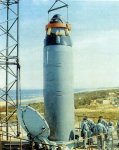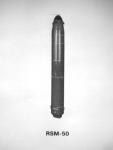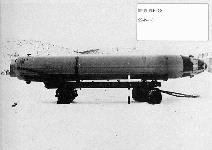





The R-29R, the R-29RL and the R-29RK were based on the R-29 single-warhead SLBM. The missiles incorporated the first two stages of the R-29 missile largely unchanged. However, instead of the single reentry vehicle and instrument module on the R-29, the R29R features a post-boost vehicle with either a single warhead or three or seven multiple independently targetable reentry vehicles. The single warhead missile has a maximum range of 8000 km, whereas the MIRVed missiles have a range 6500 km.
The post-boost vehicle includes an instrument-assembly module, a guidance system and a propulsion system. The propulsion system of the post-boost vehicle consists of a four-chamber liquid-propellant rocket engine providing for independent warhead targeting. The combustion chambers of the engine are placed on an external conical support structure. The blunt shaped warheads, oriented at an angle of the centerline of the missile, are positioned opposite of the flight direction. They are positioned in a conical shaped internal cavity at the bottom of the forward second stage fuel tank. The bus also dispenses ballistic missile defense countermeasures.
Based on the D-9 launch system, the D-9R launch system was developed in the mid-1970s to provide a capability for launching MIRVed missiles. The flight tests of the R-29R missiles took place from November 1976 throughl October 1978 in the White and Barents Seas on board of the "K-441" Delta III submarine. Of the 22 missiles that were tested, 4 carried a single warhead, 8 carried three MIRVs and 12 were tested with seven MIRVs.
Fourteen 667 BDR Delta III submarines were outfitted with the D-9R launch system and R-29R missiles.
The SS-N-18 missile carrying seven MIRVs was not deployed. In compliance with the START-1 treaty all missiles are considered to carry four MIRVs.
Specifications |
||||
|
Mod1 |
Mod2 |
Mod3 |
||
|
DIA |
SS-N-18 |
SS-N-18 |
SS-N-18 |
|
|
NATO |
Stingray |
Stingray |
Stingray |
|
|
Bilateral |
RSM-50 |
RSM-50 |
RSM-50 |
|
|
Service |
R-29R |
R-29R |
R-29R |
|
|
OKB/Industry |
3M40 |
|||
|
Design Bureau |
NII Mashinostroyeniya |
NII Mashinostroyeniya |
NII Mashinostroyeniya |
|
|
Approved |
||||
|
Years of R&D |
1973- |
1973- |
1973- |
|
|
Engineering and Testing |
||||
|
First Flight Test |
||||
|
IOC |
||||
|
Deployment Date |
1979 |
|||
|
Launch system |
D-9R |
D-9R |
D-9R |
|
|
Submarine |
Delta III |
Delta III |
Delta III |
|
|
Type of Warhead |
Single |
MIRVed |
MIRVed |
|
|
Warheads |
1 |
3 |
7 |
|
|
Yield (mt) |
0.450 |
0.2 |
0.1 |
|
|
Payload (t) |
1.6 |
1.6 |
1.6 |
|
|
Total length (m) |
14.1 |
14.1 |
14.1 |
|
|
Total length w/o warhead (m) |
||||
|
Missile Diameter (m) |
1.8 |
1.8 |
1.8 |
|
|
Diameter of Stabilizers (m) |
||||
|
Launch Weight (t) |
35.3 |
35.3 |
35.3 |
|
|
Fuel Weight (t) |
||||
|
Range (km) |
8000 |
6500 |
6500 |
|
|
CEP (m) (Russian Sources) |
900 |
900 |
900 |
|
|
CEP (m) Western Sources) |
||||
|
Number of Stages |
2 plus post boost vehicle |
|||
|
Warheads deployed |
||||
|
Booster guidance system |
Astroinertial |
|||
|
1st stage |
2nd stage |
|||
|
Length (m) |
||||
|
Body diameter (m) |
||||
|
Fueled weight (t) |
||||
|
Dry weight (t) |
||||
|
Engine Designation |
||||
|
Propellants |
Liquid |
|||
|
Fuel |
||||
|
Oxidizer |
||||
|
Burning time (s) |
||||
|
Verniers Thrust Sea Level/Vacuum (kn) |
||||
|
Specific Impulse (s) |
||||
|
Launching Technique |
||||
|
Firing conditions:
|
||||
|
Deployed boosters |
||||
|
Test Boosters |
||||
|
Warheads Deployed |
||||
|
Training Launchers |
||||





